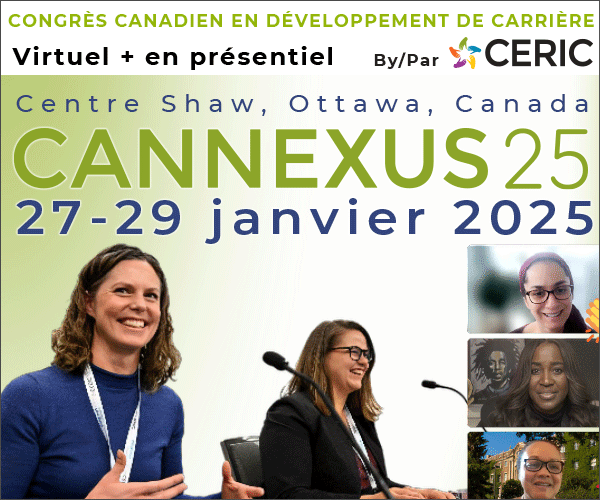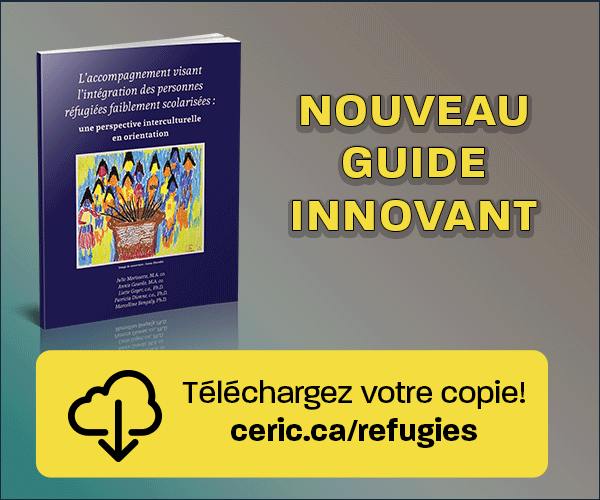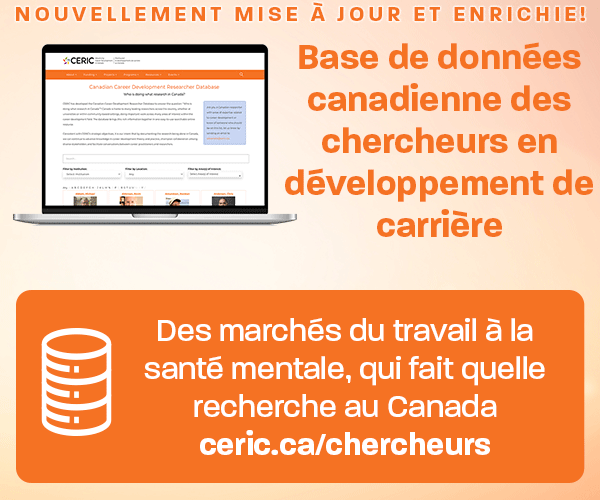Considérations sur l'orientation professionnelle pour les mères qui retournent au travail
DOI :
https://doi.org/10.53379/cjcd.2023.353Mots-clés :
développement de carrière, les mères retournant au travail, les mères qui travaillent, théories de carrière, interventions de conseilRésumé
Les femmes qui reprennent le travail après avoir été mères sont confrontées à des défis complexes, notamment des changements dans leur concept de soi, leurs priorités, leur confiance en soi et leurs croyances en matière de carrière. Pour soutenir efficacement les mères qui envisagent de réintégrer le marché du travail, les conseillers d'orientation professionnelle doivent comprendre l'interaction unique entre la vie familiale, communautaire et professionnelle antérieure de leurs clientes et son impact sur leur développement de carrière. Cet article intègre les concepts pertinents des théories du développement de carrière de Super, Krumboltz et de la théorie sociale cognitive de la carrière à la littérature actuelle afin d'éclairer les interventions de conseil en carrière visant à optimiser les expériences de réintégration des mères qui retournent au travail.
Références
Cabrera, E. F. (2007). Opting out and opting in: Understanding the complexities of women’s career transitions. Career Development International, 12(3), 218-237. http://dx.doi.org/10.1108/13620430710745872
Chae, M. H. (2002). Counseling reentry women: An overview. Journal of Employment Counseling, 39(4), 146-152. https://doi.org/10.1002/j.2161-1920.2002.tb00846.x
Coogan, P. A., & Chen, C. P. (2007). Career development and counselling for women: Connecting theories to practice. Counselling Psychology Quarterly, 20(2), 191-204. http://dx.doi.org/10.1080/09515070701391171
Ekstrom, R. B., Beier, J. J., Davis, E. L., & Gruenberg, C. B. (1981). Career and educational counseling implications of women’s life experience learning. Personnel & Guidance Journal, 60(2), 97-101. https://doi.org/10.1002/j.2164-4918.1981.tb00650.x
Ericksen, K. S., Jurgens, J. C., Garrett, M. T., & Swedburg, R. B. (2008). Should I stay at home or should I go back to work? Workforce reentry influences on a mother’s decision-making process. Journal of Employment Counseling, 45(4), 156-167. https://doi.org/10.1002/j.2161-1920.2008.tb00055.x
Jackson, A. P., & Scharman, J. S. (2002). Constructing family-friendly careers: Mothers’ experiences. Journal of Counseling & Development, 80(2), 180-186. http://dx.doi.org/10.1002/j.1556-6678.2002.tb00181.x
Johnston, D. D., & Swanson, D. H. (2007). Cognitive acrobatics in the construction of worker-mother identity. Sex Roles, 57(5-6), 447-459. http://dx.doi.org/10.1007/s11199-007-9267-4
Killy, K. E., & Borgen, W. A. (2000). Self-confidence and the re-entry experience for North American women. International Journal for the Advancement of Counselling, 22(2), 119-130. https://link.springer.com/article/10.1023/A:1005429615195
Krumboltz, J. D. (2009). The happenstance learning theory. Journal of Career Assessment, 17(2), 135-154. http://dx.doi.org/10.1177/1069072708328861
Krumboltz, J. D., Mitchell, A. M., & Jones, G. B. (1976). A social learning theory of career selection. Counseling Psychologist, 6(1), 71-81. https://doi.org/10.1177/001100007600600117
Lent, R. W., & Brown, S. D. (1996). Social cognitive approach to career development: An overview. Career Development Quarterly, 44(4), 310. https://doi.org/10.1002/j.2161-0045.1996.tb00448.x
Locke, W. S., & Gibbons, M. M. (2008). On her own again: The use of narrative therapy in career counseling with displaced new traditionalists. The Family Journal, 16(2), 132-138 https://doi.org/10.1177/1066480708314258
Lovejoy, M., & Stone, P. (2012). Opting back in: The influence of time at home on professional women’s career redirection after opting out. Gender, Work and Organization, 19(6), 631-653. http://dx.doi.org/10.1111/j.1468-0432.2010.00550.x
Miller, S. (1996). Questioning, resisting, acquiescing, balancing: New mothers’ career reentry strategies. Health Care for Women International, 17(2), 109-131. https://doi.org/10.1080/07399339609516227
Mitchell, K. E., Levin, A. S., & Krumboltz, J. D. (1999). Planned happenstance: Constructing unexpected career opportunities. Journal of Counseling and Development, 77(2), 115-124. https://canvas.wisc.edu/files/42959/download?download_frd=1&verifier=caP62PzAqk5QStLMj6KrA2onMByNOjgvvItndNeU
Morgan, B., & Foster, V. (1999). Career counseling for reentry dual career women: A cognitive development approach. Journal of Career Development, 26(2), 125-136. https://link.springer.com/article/10.1023/A:1022906326894
Oberman, Y., & Josselson, R. (1996). Matrix of tensions: A model of mothering. Psychology of Women Quarterly, 20(3), 341-359. https://doi.org/10.1111/j.1471-6402.1996.tb00304.x
Padula, M. A. (1994). Reentry women: A literature review with recommendations for counseling and research. Journal of Counseling & Development, 73(1), 10-16. https://doi.org/10.1002/j.1556-6676.1994.tb01703.x
Rubin, S.E., & Wooten, H.R. (2007). Highly educated stay-at-home mothers: A study of commitment and conflict. Family Journal, 15(4), 336-345. https://doi.org/10.1177/1066480707304945
Schlossberg, N. K., Lynch, A. Q., & Chickering, A. W. (1989). Improving higher education environments for adults. Jossey-Bass.
Schultheiss, D. E. P. (2009). To mother or matter: Can women do both? Journal of Career Development, 36(1), 25-48. http://dx.doi.org/10.1177/0894845309340795
Shapiro, M., Ingols, C., & Blake-Beard, S. (2008). Confronting career double binds: Implications for women, organizations, and career practitioners. Journal of Career Development, 34(3), 309-333. http://dx.doi.org/10.1177/0894845307311250
Sharf, R. S. (2013). Applying career development theory to counseling (6th ed.). Brooks/Cole.
Sullivan, S. E., & Mainiero, L. (2008). Using the kaleidoscope career model to understand the changing patterns of women’s careers: Designing HRD programs that attract and retain women. Advances in Developing Human Resources, 10(1), 32-49. http://dx.doi.org/10.1177/1523422307310110
Sullivan, S. E., & Mainiero, L. A. (2007). Kaleidoscope careers: Benchmarking ideas for fostering family-friendly workplaces. Organizational Dynamics, 36(1), 45-62. https://digitalcommons.fairfield.edu/cgi/viewcontent.cgi?referer=&httpsredir=1&article=1059&context=business-facultypubs
Super, D. E. (1980). A life-span, life-space approach to career development. Journal of Vocational Behavior, 16(3), 282-296. https://doi.org/10.1016/0001-8791(80)90056-1
Vejar, C. M., Madison-Colmore, O., & Ter Maat, M. B. (2006). Understanding the transition from career to fulltime motherhood: A qualitative study. American Journal of Family Therapy, 34(1), 17-31. https://www.tandfonline.com/doi/abs/10.1080/01926180500301352

Téléchargements
Publié-e
Comment citer
Numéro
Rubrique
Licence
(c) Tous droits réservés La Revue canadienne de développement de carrière 2023

Cette œuvre est sous licence Creative Commons Attribution - Pas d'Utilisation Commerciale - Pas de Modification 4.0 International.











